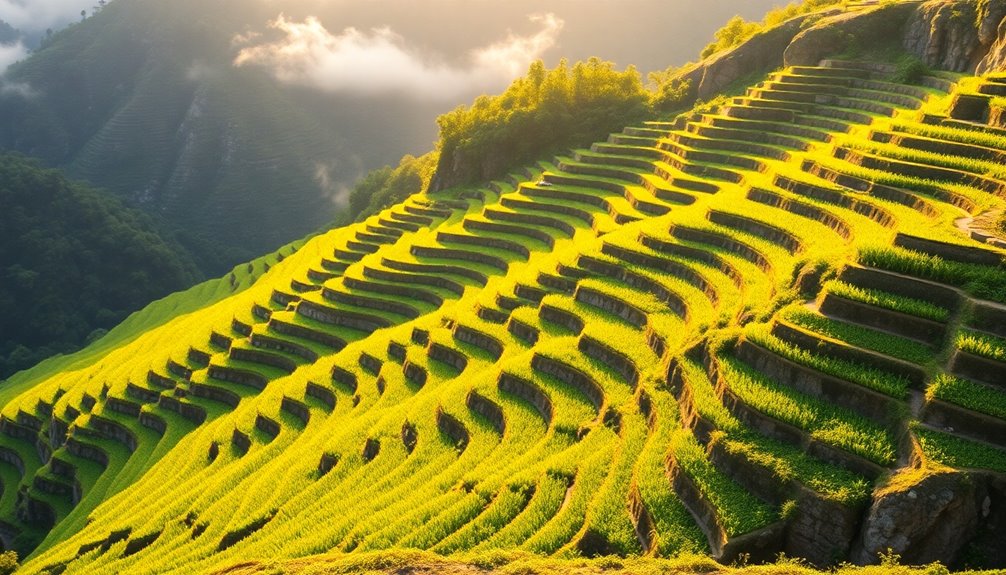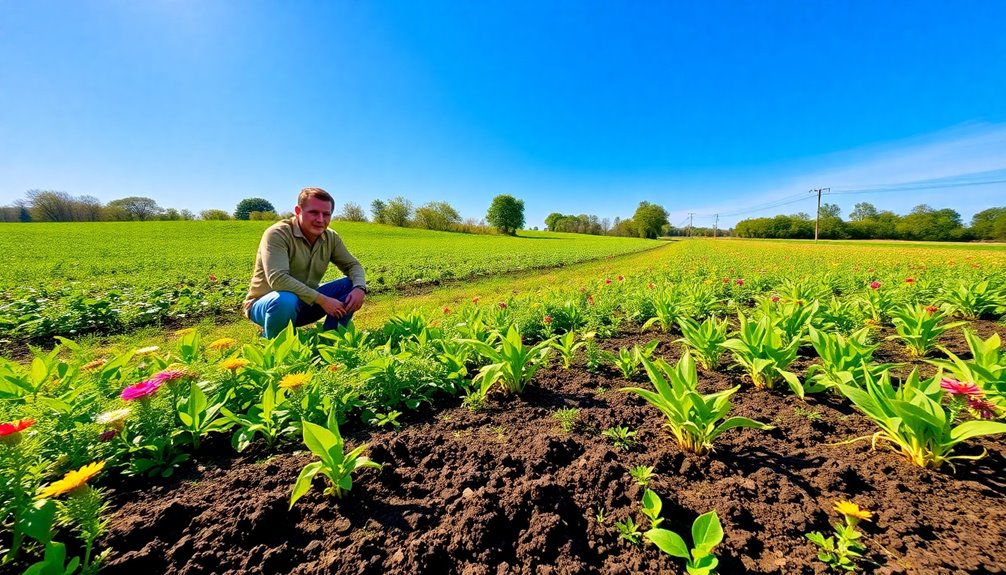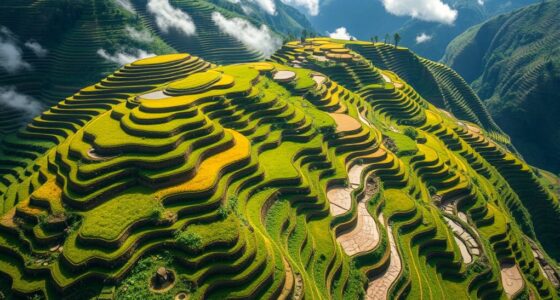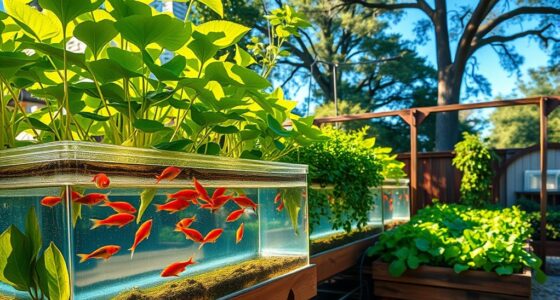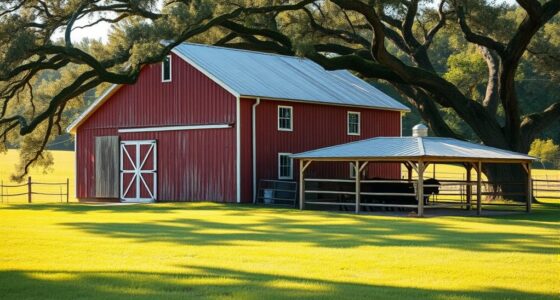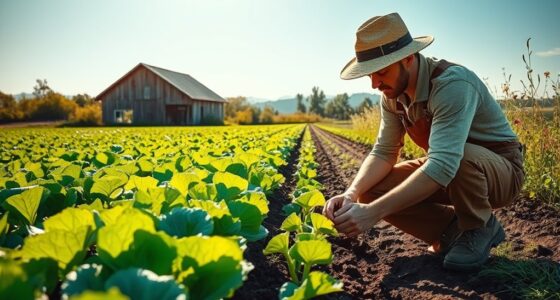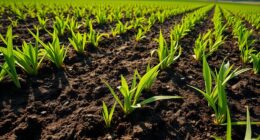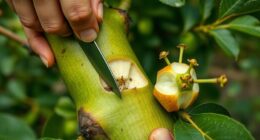Terrace farming is an innovative technique that transforms sloped land into tiered platforms, maximizing your agricultural potential. By creating these flat areas, you reduce soil erosion and improve water retention, boosting crop yields by up to 44.8%. This method not only enhances food production but also conserves nutrients and promotes sustainable practices. You'll find that terrace farming allows you to utilize steep terrains effectively, proving beneficial for various crops. If you've ever wondered how to revolutionize your land use, just imagine the possibilities that await as you explore further into the many advantages of this technique.
Key Takeaways
- Terrace farming creates stepped platforms on sloped land, enhancing arable space and improving water management for crops.
- This ancient technique reduces soil erosion and boosts nutrient retention, promoting healthier crop yields and improved moisture levels.
- Ideal crops include grains, legumes, and fruits, chosen based on local climate and soil for optimal growth and yield.
- Crop rotation in terrace farming enhances soil health, prevents nutrient depletion, and reduces pest prevalence, stabilizing agricultural productivity.
- While labor-intensive, terrace farming offers significant benefits such as improved fertility and increased food production potential on otherwise unusable land.
Definition of Terrace Farming
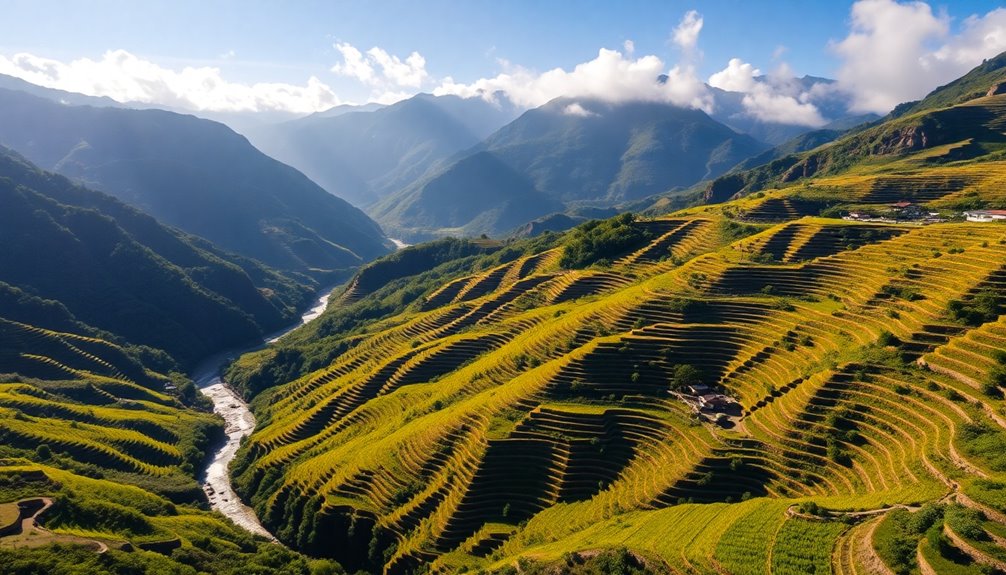
Terrace farming, an ancient agricultural technique, involves creating stepped platforms on hilly or mountainous land to enhance arable space and manage water runoff.
This method effectively reduces soil erosion by slowing down water flow and trapping nutrients, playing a crucial role in soil conservation on steep slopes. By constructing terraces, you can intercept rainfall, channeling water underground and minimizing surface erosion, which boosts crop survival rates.
Each terrace level is specifically designed to retain water and support diverse crop cultivation, making this agricultural practice an effective solution for regions that struggle with traditional farming methods.
If you're facing challenges in maximizing your land's potential, terrace farming could be the innovative approach you need for sustainable agriculture.
Historical Context
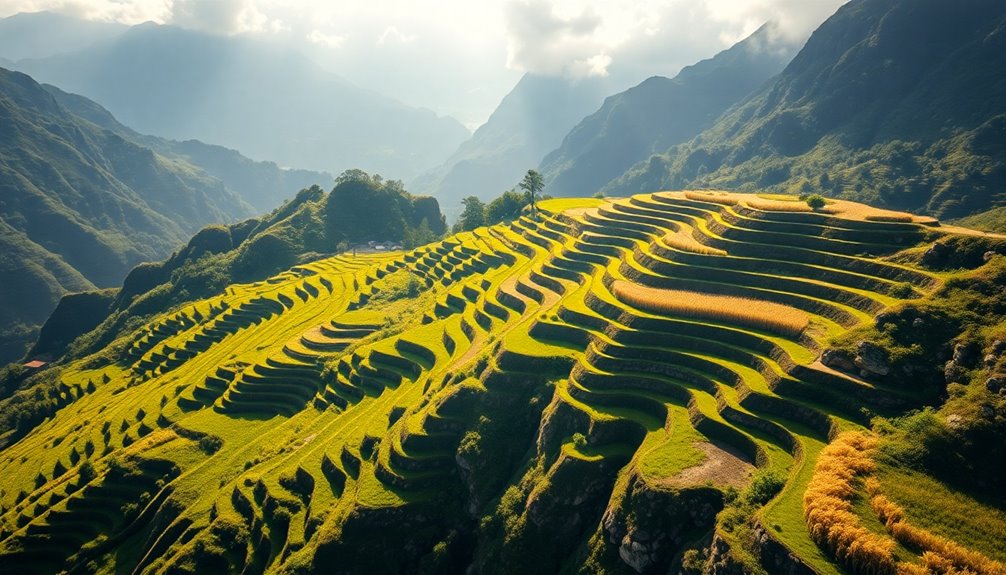
When you explore the history of terrace farming, you'll find it rooted in ancient civilizations like Mesopotamia, where innovative practices shaped agriculture.
The Incas in the Andes and the stunning rice terraces of Southeast Asia further illustrate how these methods adapted to diverse landscapes.
Today, UNESCO recognizes sites like the Philippine Rice Terraces, highlighting their cultural and historical importance in sustainable farming.
Ancient Civilizations' Practices
Ancient civilizations mastered various agricultural techniques, and among them, terrace farming stands out as a remarkable innovation. This method, seen in places like Mesopotamia, allowed them to cultivate crops effectively on steep slopes.
The Incas, for instance, showcased extensive terrace farming at Machu Picchu, enhancing agricultural productivity while adapting to the rugged terrain of the Andes. Similarly, rice terraces in Southeast Asia, particularly in Vietnam and Indonesia, illustrate the technique's flexibility to local environments.
These practices not only boosted yields but also served as a crucial soil conservation practice, helping to prevent soil erosion. By managing water resources efficiently, ancient civilizations demonstrated how terrace farming could transform challenging landscapes into productive agricultural land.
UNESCO World Heritage Sites
Throughout history, cultures have developed remarkable agricultural systems that adapt to their environments, with terrace farming being a prime example.
The Philippine Rice Terraces, built over 2,000 years ago, stand as a UNESCO World Heritage Site, celebrated for their cultural significance and innovative agricultural practices. These terraces exemplify sustainable land management, preserving biodiversity while yielding rice in challenging terrains.
Similarly, the Inca civilization at Machu Picchu utilized terrace farming on the steep Andes, showcasing advanced engineering.
Across Southeast Asia, including Vietnam and Indonesia, ancient agricultural traditions continue to thrive through these tiered systems. Additionally, these practices can be seen as a form of cognitive enhancement through their intricate designs, which require careful planning and attention to detail.
UNESCO's recognition of these sites highlights the enduring impact of terrace farming on both history and sustainable agriculture, reminding us of our responsibility to preserve these remarkable landscapes.
Mechanism of Terrace Farming
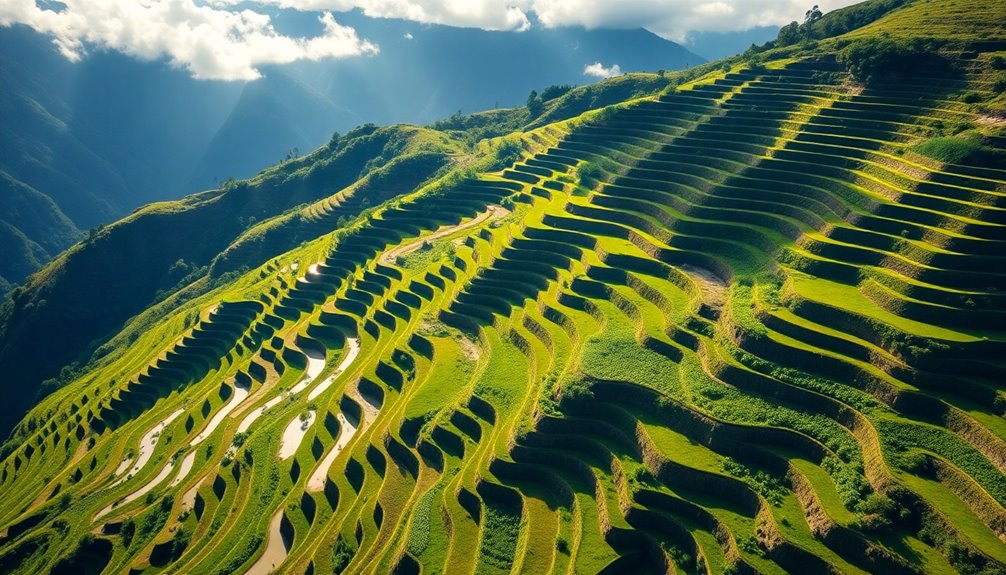
The effectiveness of terrace farming lies in its innovative design, which transforms sloped land into manageable, flat layers. By creating these terraces, you greatly reduce water runoff velocity, minimizing risks of soil erosion and mudslides.
Each flat layer retains water, ensuring your crops have adequate moisture while preventing topsoil loss during heavy rains. This mechanism channels water underground, promoting effective soil conservation and enhancing nutrient retention without harming the ecosystem.
Each terrace acts as a barrier, slowing water movement and allowing for increased infiltration. To maintain ideal crop production and long-term soil health, precise alignment and maintenance are essential, preventing oversaturation and nutrient depletion while boosting overall water conservation efforts in your agricultural practices.
Advantages of Terrace Farming
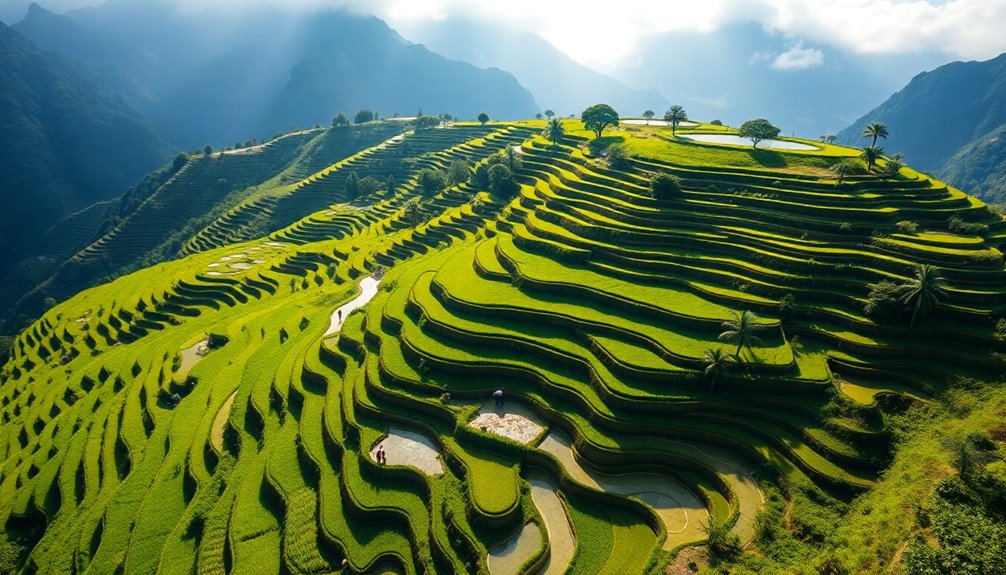
One of the key benefits of terrace farming is its ability to transform steep, previously unproductive land into arable fields, greatly boosting food production potential. This method not only enhances land productivity but also actively promotes soil conservation by considerably reducing erosion. With improved water retention, terrace farming increases soil moisture content, resulting in healthier crops.
| Advantage | Impact |
|---|---|
| Increased Land Productivity | Up to 44.8% grain yield improvement |
| Soil Conservation | Reduces sediment loss by 52% |
| Enhanced Water Retention | Improves soil moisture by 12.9% |
Disadvantages of Terrace Farming
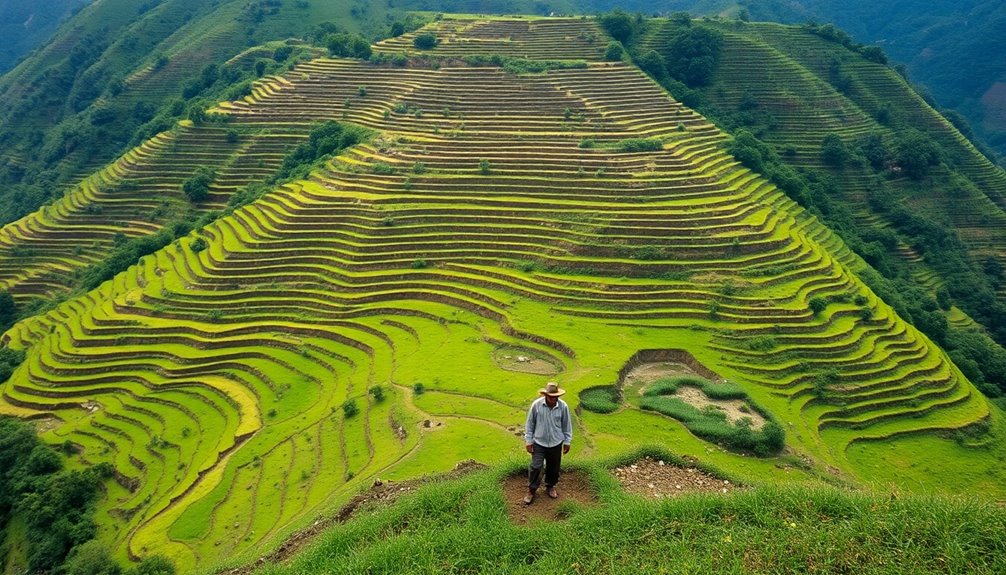
While terrace farming offers numerous advantages, it also comes with significant drawbacks that can impact its overall effectiveness.
One major disadvantage of terrace farming is the labor-intensive nature of constructing and maintaining terraces. If you have poorly designed terraces, you might face uneven water distribution, leading to oversaturation or drought for your crops.
Aging and mismanaged terraces can exacerbate soil erosion, increasing runoff by 1–5 times instead of mitigating it. This not only threatens soil fertility but also complicates water circulation, causing sedimentation issues.
Without regular maintenance of terraces, long-term sustainability is at risk, potentially resulting in reduced agricultural yields over time.
Understanding these disadvantages is essential for making informed decisions about your farming practices.
Types of Terraces
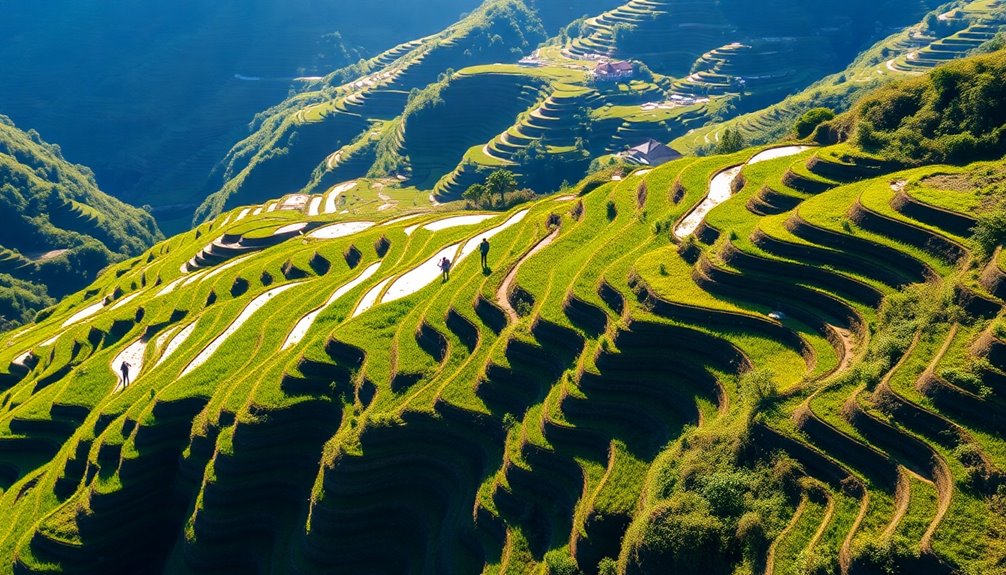
When considering terrace farming, understanding the different types of terraces is essential for successful implementation.
Broad-base terraces work well on gentle hills, allowing machinery access on slopes up to 8%, thereby enhancing farming efficiency.
Grassed back-slope terraces use perennial grass to optimize water retention and prevent erosion by moving soil from the downhill area.
Narrow-base terraces are the steepest type and require less earth for construction, often supported by vegetation for stability.
Bench terraces are labor-intensive and resemble steps, making them ideal for rice farming due to their effectiveness in retaining water.
Finally, contour terracing follows the land's natural contours, minimizing soil disturbance and creating unique farming spaces that can be challenging to manage yet beneficial for soil conservation.
Sustainability and Soil Conservation
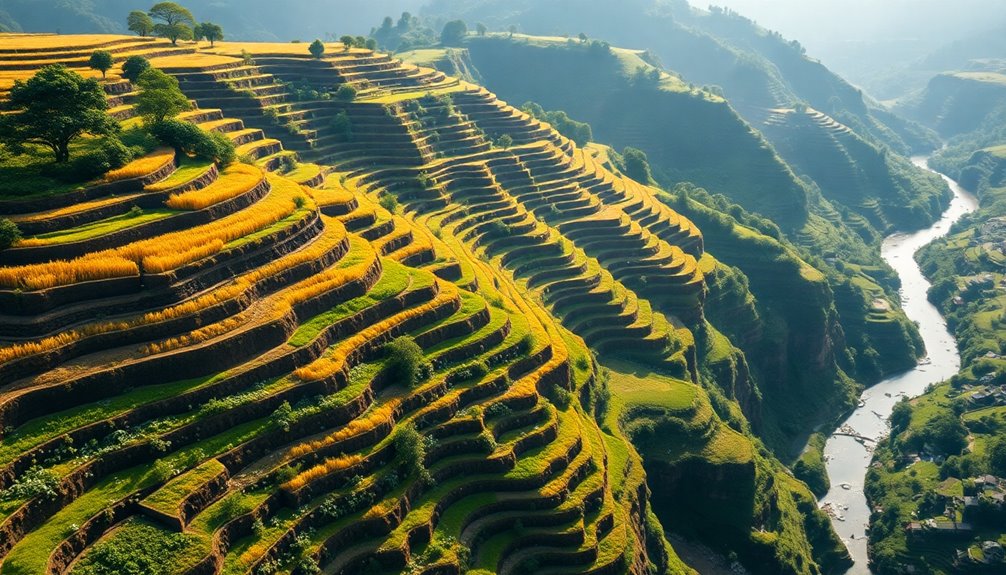
Terrace farming plays an essential role in promoting sustainability and soil conservation, especially in hilly regions. By slowing down water flows, this method reduces soil erosion considerably, decreasing sediment loss by up to 52% compared to conventional farming.
You'll find that it enhances soil moisture retention by 12.9%, which is critical for crop survival and productivity in sloped terrains. The design of terraces breaks large slopes into manageable sections, minimizing gravitational forces and promoting long-term soil conservation.
However, remember that regular maintenance is important; poorly maintained terraces can increase soil loss and decrease agricultural productivity. Embracing terrace farming supports sustainable agricultural practices, enhances biodiversity, and contributes to the conservation of local ecosystems.
Crop Choices in Terrace Farming
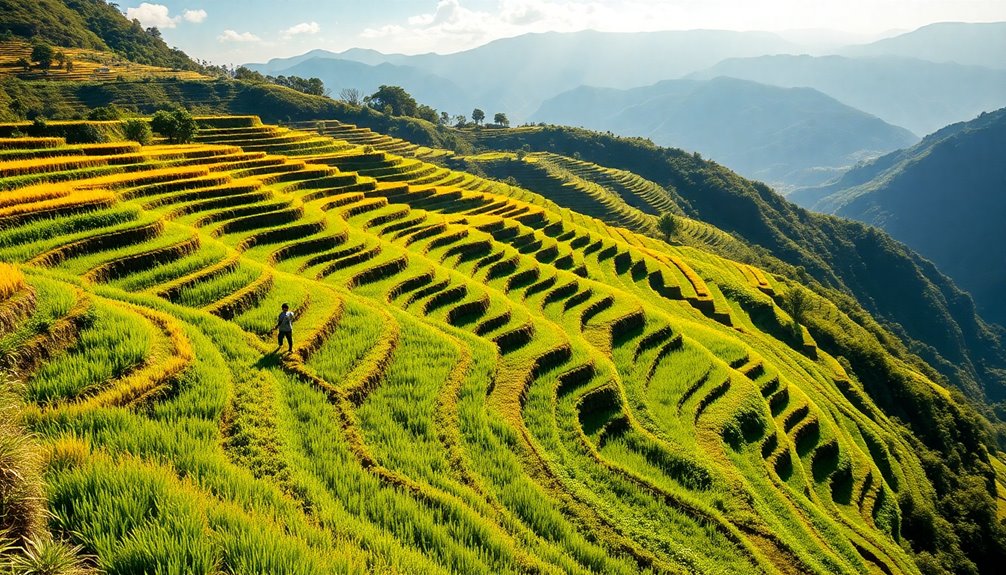
Effective crop choices are essential for maximizing the benefits of terrace farming. By selecting the right crops, you can enhance soil conservation and boost the productivity of your agricultural land. Common choices include grains like wheat and corn, along with legumes and fruits such as buckwheat and apples.
Incorporating crop rotation into your terrace cultivation not only improves soil health but also stabilizes yields—research shows grain yields can increase by up to 44.8% with terraced plots. Certain crops, like saffron and pulses, thrive in the nutrient-rich, moisture-retentive soils typical of terraces.
Frequently Asked Questions
What Is Terracing Farming Techniques?
Terrace farming techniques involve creating stepped levels on sloped land to optimize farming.
You'll design terraces based on the slope and soil conditions, choosing between broad-base, narrow-base, or contour terraces. This method enhances water retention and minimizes soil erosion, making your crops more productive.
Regular maintenance is essential to guarantee proper water distribution and prevent oversaturation.
What Were Terrace Farms and Why Were They Important?
Terrace farms were ingenious agricultural creations that transformed steep landscapes into productive spaces.
They played a crucial role in ancient civilizations, allowing you to cultivate crops where flat land was scarce.
These stepped levels not only prevented soil erosion but also managed water runoff, ensuring your crops thrived.
Is Terrace Farming Good or Bad?
Terrace farming can be both good and bad, depending on how it's managed.
When done right, you'll see improved soil retention and increased crop yields, making it a sustainable option for steep slopes.
However, if you neglect maintenance or design, it can lead to increased runoff and soil loss.
Regular oversight is key; otherwise, you risk infertility and decreased productivity.
How Did Terrace Farming Help Increase Production?
Terrace farming boosts production by optimizing land use on steep slopes, enhancing soil moisture retention.
You'll notice a significant reduction in water runoff, which helps retain moisture in the soil for healthier crops.
This technique minimizes sediment loss, preserving soil quality and nutrients.
Plus, it allows you to cultivate a variety of crops, maximizing yield and contributing to food security.
Effective water management in terraces guarantees your plants thrive and produce abundantly.
Conclusion
In summary, while you might worry that terrace farming requires too much initial effort, consider the long-term benefits it brings. By transforming sloped land into productive terraces, you're not just optimizing space; you're also preserving soil and water resources. This technique can lead to sustainable farming practices that yield healthier crops and protect the environment. Embrace terrace farming, and you'll see how it can revolutionize your land use, proving that hard work today pays off tomorrow.

